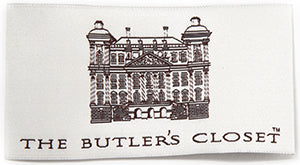The Bata Shoe Museum––an Interview with Conservator Ada Hopkins
You probably think the UGG boot was a startling, modern invention, but having had a private tour of the Bata Shoe Museum’s archives, I can tell you that UGG boots are not a new idea at all but a very old one invented by Indigenous North American––living in arctic circumstances––who created and wore circumpolar footwear.
On a blustery, grey January day in Toronto, I visited this jewel box museum that houses the most spectacular shoe collection in North America.
The museum was founded by Sonja Bata and “holds over 13,000 shoes and related artifacts spanning 4,500 years of footwear history.“ Mrs. Bata, Swiss by birth, married Thomas Bata the Czech-Canadian “heir and head of the global shoe manufacturing and retail empire” known as The Bata Shoe Company. As Mrs. Bata traveled the world for business, she built an astonishing collection of shoes and founded a foundation in 1979 that eventually led to the establishment of the museum.
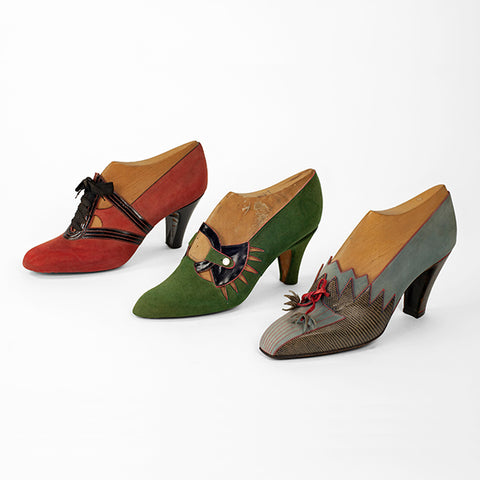 Image ©2019 The Bata Shoe Museum, Toronto, Canada
Image ©2019 The Bata Shoe Museum, Toronto, Canada
Trio of colorful Preciosa shoes
Ada Hopkins is the Conservator of this extraordinary collection and generously agreed to meet with me to discuss proper shoe storage in one’s home. The timing of my trip was fortuitous as the museum’s Manolo Blahnik exhibition was in its final week. As a shoe aficionado, I did not want to miss it.
Ada Hopkins was a talented textile conservator when she was recruited by the museum to conserve their large collection of 18th century shoes. These precious shoes had textile “uppers” and Ada’s expertise and knowledge was required for their preservation. She has been at the museum for 31 years and her experience in shoe conservation is unparalleled.
As I quickly learned, any assumption that tips and guidance about shoe storage would be straightforward was misguided because the subject is complex. In the case of shoe storage, to use a well-worn phrase, one size does not fit all. Each material has its own properties and what is good storage for your best leather heels may not work for your running shoes. And I also learned that shoe trees may do more harm than good.
My shoes are stored in my closet in plastic boxes or in their original cardboard shoe boxes so my first question was about my own methods. Ada responded saying that plastic boxes made from polyethylene or polypropylene are considered acceptable because the materials are inert. But she added caveats as our discussion progressed.
First we discussed leather. According to Ada, when leather loses moisture, it can dry out and then shrink. Leather shoes can stretch when worn, then sag if unsupported when stored. Leather on the outside of a shoe differs from the leather in the insole and the leathers can react to their environment at different rates.
We have all had leather or suede shoes that stretch and fit differently after they have been worn. But if left untouched for months (or years) dust can accumulate. Humidity in a home or apartment fluctuates and if a pair of shoes has an invisible coat of dust that becomes imbedded in the leather or caught in the nap of the suede, it can harden and shoes can shrink. Keeping shoes clean and dust free is a must.
Shoetrees––made from wood or plastic––also create problems. They apply pressure and put stress on shoes. Very dry leather can crack from this stress. Wood is acidic so if you have wooden shoe trees the acid can migrate and cause additional problems.
Many of the elegant and fashionable vintage shoes in the Bata Shoe Museum’s collection were manufactured with custom-made, wooden shoe forms that filled the whole shoe serving as a heel to toe shoe tree. Many of these shoe forms are made in three pieces––one for the heel, one for the toe block and one that fits in the middle that holds the other two pieces in place. The middle piece usually has a metal ring used to remove the entire wooden form.
Sometimes, when the museum has a new acquisition that comes with a custom fitted shoe form, the vintage shoe has shrunk tightly around the form. Ada does not use shoe trees in the collection and if a shoe comes into the collection with a shoe tree she removes it. If an acquisition comes with a full wooden shoe form (like that described above) she will use the metal ring to lift the center block of the three pieces of wood to “release” the pieces and relieve stress on the heel and toe.
While Ada said one can use plastic boxes at home, the use of plastic may seem counter-intuitive when one thinks about conservation but polyethylene and polypropylene are materials regularly used in conservation because they are inert.
Ada’s first admonition about storage was about shoes’ materials and construction and the significant amount of synthetic materials in use. A good deal of today’s fashion footwear is made from plastic or plastic-like materials and we may not be aware of that fact. If there is plastic in the footwear, it can out-gas in a sealed, plastic shoe box and deterioration might accelerate.
Footwear manufacturers don’t detail the type of plastic or the synthetic textiles in a shoe you have bought. Elastics such as spandex are made from polyurethane. Most of us have seen plastic waistbands stretch and deteriorate and this is a result of the breakdown of this material over time.
Plastics have been used in shoe construction since the early 1900s. Their use took off in the 1960s. The wet look was very popular and straps that looked crystal clear when first manufactured might look cloudy today as the materials deteriorate over time. A wide range of synthetic textiles and plastics can be found in today’s shoes.
Some plastics deteriorate and become sticky. If one uses fabric or paper in the storage box, the fabric may leave an impression on the shoe’s plastic surface. Sneakers, the ubiquitous and universal shoe, should be left in their original cardboard boxes. You can buy a plastic film with a silicone coating on one side and line your sneaker shoe box with that so if the plastic deteriorates, it won’t stick to the storage container. Talas, a highly regarded source of conservation materials carries silicone coated mylar sheets that work for this purpose.
The Container Store sells clear, polypropelene shoe boxes in various sizes for men’s and women’s shoes. While I don’t love recommending plastic, I have used these boxes for years and have found that they keep the dust off and allow me to see what is in each box. Most of my shoes are stored this way and some are in their original shoe boxes. I have everything stacked on shelves in my closet so they are readily visible and accessible. While lots of people take their shoes out of the boxes and leave them exposed, if you do so dust will inevitably accumulate both on the inside and outside of the shoe. Archival boxes for shoes and boots are available online at Talas.
After our initial discussion about shoe care, Ada gave me a private tour of the museum’s archival storage area that is not open to the public. There were two very large rooms with shelves and shelves and shelves of shoes from every era. Most were organized chronologically. Some of the shoes are also organized by geography.
One can hardly imagine the depth and breadth of human creativity when it comes to footwear and it is all on display at The Bata Shoe Museum.
The museum’s collection starts with an exact reproduction of the earliest know, prehistoric footwear––belonging to the Ötzi Man, found in the European Alps and estimated to be 5,300 years old––and extends into the 21st century.
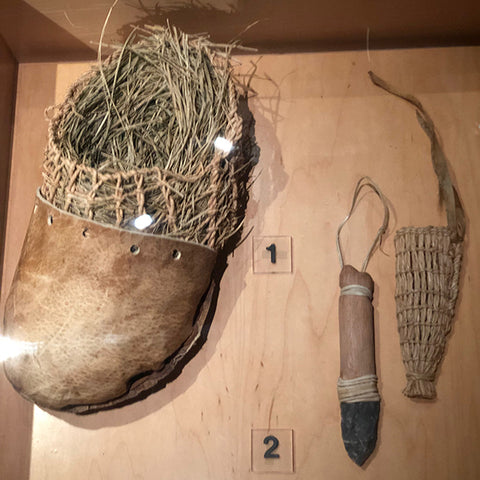 Image The Butler's Closet
Image The Butler's Closet
Prehistoric Ötzi man footwear reproduction
It includes miniaturized shoes worn by Chinese courtesans whose feet were bound as well as gigantic, high and wide thick leather boots that stretched up the thighs of burly men whose job it was to work in peat bogs.
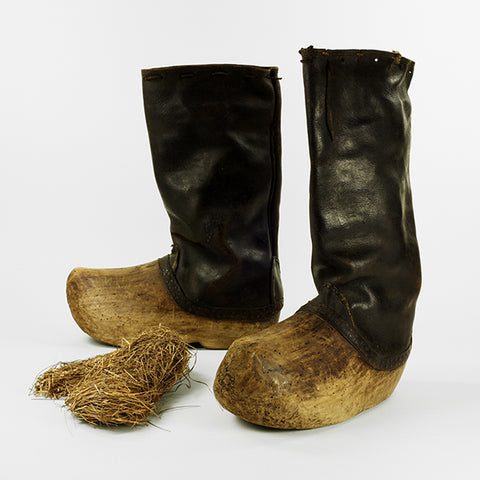 Image ©2019 The Bata Shoe Museum, Toronto, Canada
Image ©2019 The Bata Shoe Museum, Toronto, Canada
Peat Bog Boots
The collection also includes other functional footwear like wooden clogs with knife-like metal protrusions that allowed the men wearing these clogs to drive the sharpened slabs into the side of trees to give them leverage and support as they climbed up to do their work.
The storage rooms were fascinating. Ada showed me the most luxurious shoes worn at European courts and equally fabulous shoes from the twenties and thirties in luscious colors with beautiful beading. My mouth was watering.
One of the rooms had boots made from a wide range of materials from fish skin to polar bear fur. This room is kept at a lower temperature and higher humidity than the other archive. Ada keeps some of these boots in large plastic bags because the deep fur is dense and an attractive home for moths.
This collection of shoes, ranging from moccasins to boots were all made by hand by native Americas from the arid southwestern states in the US through the most frigid climates in the Canadian northwest. Here I saw the original “UGGs” that were invented hundreds of years ago––made from the fur of seals or other animals.
Some of these fur boots had complicated fur patterns where tiny pieces had been cut and sewn together as if they were mosaics.
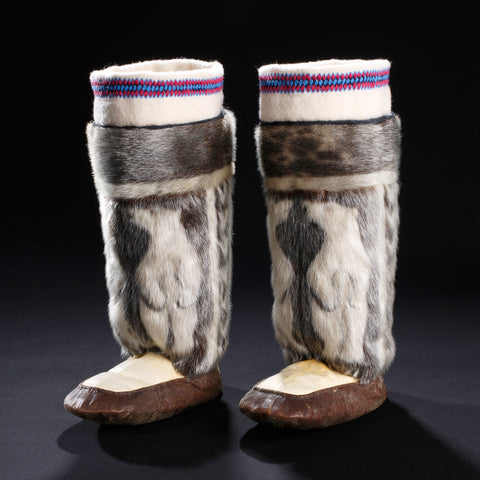 Image ©2019 The Bata Shoe Museum, Toronto, Canada
Image ©2019 The Bata Shoe Museum, Toronto, Canada
Polar Bears Boots
There were boots made from beautiful, smooth and unblemished white skins. These were from unsmoked skins. Others, a light beige, were from smoked skins. The designs were incredibly modern and all created by hand. The range of styles and furs was fantastic.
After this special tour I spent an hour visiting the museum’s shoe history time line that shows the development of footwear in a chronological fashion starting with the most primitive shoes (belonging to the Ötzi man) made from bearskin, deerskin and stuffed with grass and continuing through today’s stilettos that use all kinds of modern, and synthetic materials.
I took numerous photos. The gorgeous velvet shoe on the left was made by the famous Italian shoemaker Pietro Yantory. The Chinese theatrical boot was used in Beijing Opera performances. These and the Indian mojari show examples of 20th century craftsmanship and the extraordinary use of metallic gold thread embroidery.
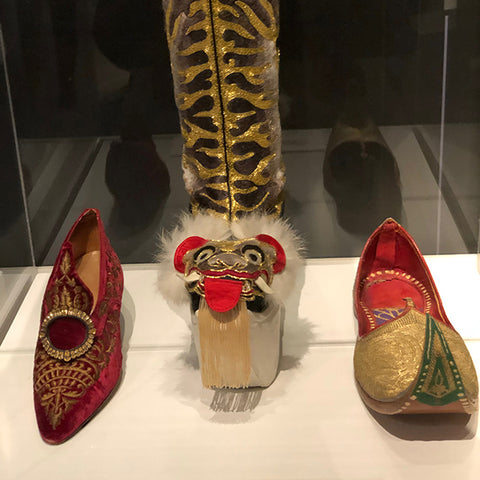 Image The Butler's Closet
Image The Butler's Closet
Metallic gold thread embroidery on shoes at the Bata Shoe Museum
Then it was on to the Manolo Blahnik exhibition. This was the cherry on top of the sundae. The Bata Museum hired a design collective to help the museum’s curator create a space and casework for the exhibition. The Blahnik team selected the shoes and drawings from their archives and then came to Toronto to help with the installation. They were due to return to pack up the shoes once the exhibition had closed in a few days.
The Blahnik exhibit was exquisite. Mr. Blahnik designed the shoes for Marie Antoinette, the movie by Sofia Coppola and there is a wonderful scene in the movie, presented in the exhibition, where the Queen goes from tears to smiles as her courtiers present the most gorgeous shoes, sumptuous fabrics and tallest hairpieces for her pleasure. Here is the official trailer for the movie.
Mr. Blahnik’s sketches of shoes are pieces of art and to dwell on his extraordinary talents brings one up tongue-tied as normal adjectives are unequal to the task of describing his imagination. Suffice it to say, these talents can still be seen today in stores around the world and in a few photos from the exhibition below:
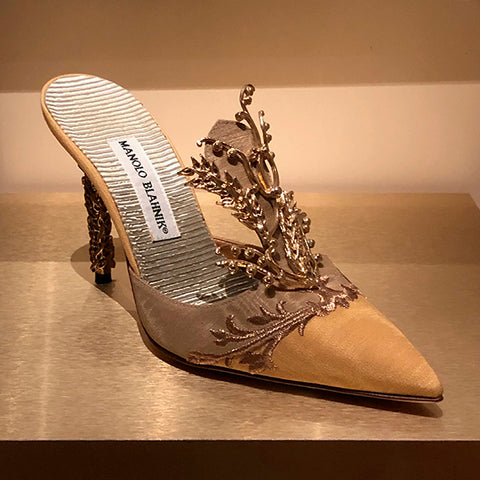 Image The Butler's Closet
Image The Butler's Closet
Manolo Blahnik elegant backless shoe with golden embroidery
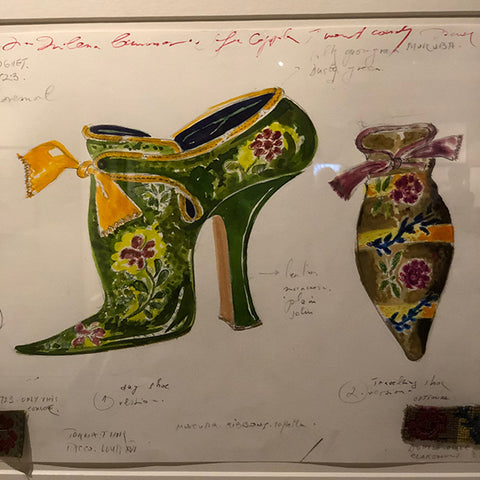 Image The Butler's Closet
Image The Butler's Closet
Manolo Blahnik illustration of shoes created for the movie Marie Antoinette
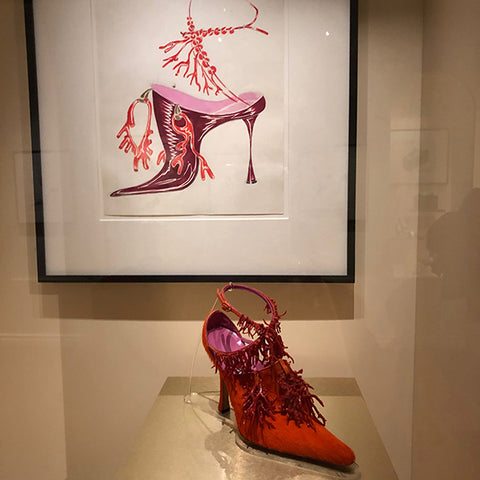 Image The Butler's Closet
Image The Butler's Closet
Manolo Blahnik dramatic red shoe and original sketch
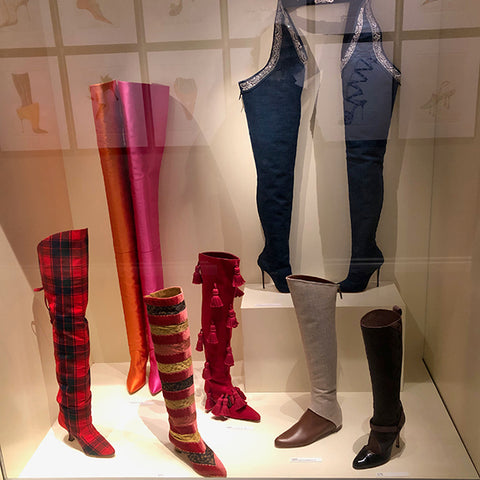 Image The Butler's Closet
Image The Butler's Closet
Magnificent Manolo Blahnik boots in various fabrics
 Image The Butler's Closet
Image The Butler's Closet
Manolo Blahnik heels in luscious colors and fabrics
Shoes are my secret passion and I can’t thank Ada Hopkins enough for my very special tour and her wise advice. After leaving the Bata Shoe Museum all I could think of was the creativity of men and women in their design and construction of shoes. The range was astonishing. Shoes made by those living in harsh climate conditions in far-away lands or bought for dancing in the most elegant ballrooms in Europe––all under the same roof––is a testament to the human need to create. Consider making a special trip to Toronto, just to see The Bata Shoe Museum. It is an experience you don’t want to miss!
